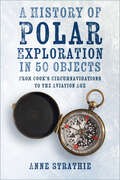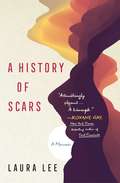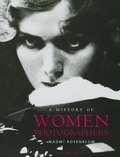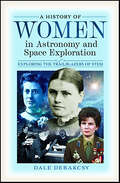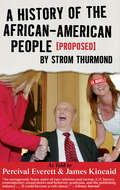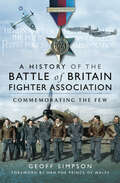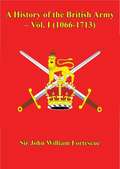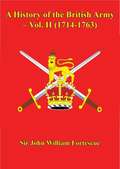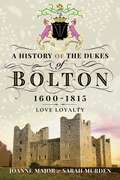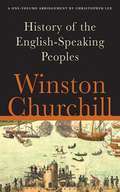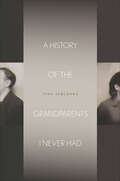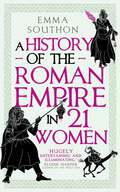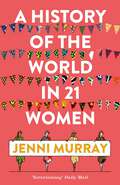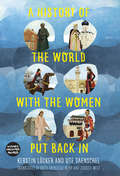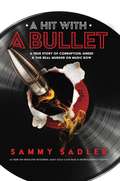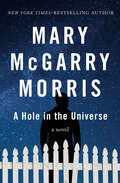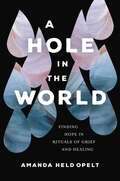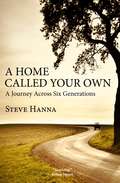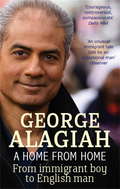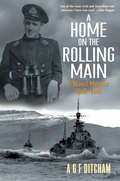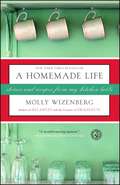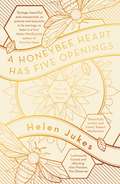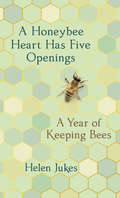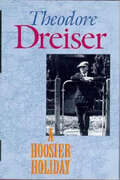- Table View
- List View
A History of Polar Exploration in 50 Objects: From Cook’s Circumnavigations to the Aviation Age
by Anne StrathieA History of Polar Exploration in 50 Objects covers just over 150 years of polar exploration during which a mysterious southern continent and an elusive northern sea-route became less incognita and increasingly charted and understood. The objects of the title include instruments used by explorers and scientists, their means of transport and representations of previously unrecorded sights and creatures. Others evidence how explorers financed expeditions, survived during them or shed light on the lives of those who awaited their return in an era before the modern communications now taken for granted. While individual objects are of their own time, they form part of a continuum of polar exploration; they also evidence networks and collaborations which bind polar explorers and scientists to each other, to other mariners and those living in or near polar regions. The 50 objects include: • Mrs. Elizabeth Cook's ditty-box made of wood from HMS Resolution. • John Ross's long-preserved canister of meat • A rock marker left by James Clark Ross for his best friend, 'Frank' Crozier • John Rae's surveying octant • Edward Wilson's portable paintbox • Ernest Shackleton's 'Farthest South' sledging-compass • A samurai sword • Matthew Henson's North Pole expedition fur suit • Roald Amundsen's fjord-side refuge • HMS Erebus's long-silent bell Some objects remain in polar regions, others are in public spaces, museums, archives and galleries all over the world. They and the stories relating to them are illustrated with almost 150 images, some rarely or not previously published. A History of Polar Exploration in 50 Objects is Anne Strathie's fourth book on polar regions and is the culmination of approaching fifteen years of research and travel in polar regions and in Britain and other countries lying between the two extremes.
A History of Scars: A Memoir
by Laura LeeFrom a writer whose work has been called &“breathtaking and dazzling&” by Roxane Gay, this moving, illuminating, and multifaceted memoir explores, in a series of essays, the emotional scars we carry when dealing with mental and physical illnesses—reminiscent of The Collected Schizophrenias and An Unquiet Mind. In this stunning debut, Laura Lee weaves unforgettable and eye-opening essays on a variety of taboo topics. In &“History of Scars&” and &“Aluminum&’s Erosions,&” Laura dives head-first into heavier themes revolving around intimacy, sexuality, trauma, mental illness, and the passage of time. In &“Poetry of the World,&” Laura shifts and addresses the grief she feels by being geographically distant from her mother whom, after being diagnosed with early onset Alzheimer&’s, is relocated to a nursing home in Korea. Through the vivid imagery of mountain climbing, cooking, studying writing, and growing up Korean American, Lee explores the legacy of trauma on a young queer child of immigrants as she reconciles the disparate pieces of existence that make her whole. By tapping into her own personal, emotional, and psychological struggles in these powerful and relatable essays, Lee encourages all of us to not be afraid to face our own hardships and inner truths.
A History of Women Photographers (Third Edition)
by Naomi RosenblumWomen have had a special relationship with the camera since the advent of photographic technology in the mid-nineteenth century. Photographers celebrated women as their subjects, from intimate family portraits and fashion spreads to artistic photography and nude studies, including Man Ray's Violon d'Ingres. Lesser known-- and lesser studied-- is the history of women photographers, who continue to make invaluable contributions to this flourishing art form. Featuring more than 300 illustrations, A History of Women Photographers is the only comprehensive survey of women photographers from the age of the daguerreotype to the present day. In this edition, author Naomi Rosenblum expands the book's coverage to include additional photographers and fourteen new images. The text and the appendix of photographer biographies have been revised throughout, and Rosenblum also provides a new afterword, in which she evaluates the influence of rapidly changing digital technology on the field of photography and the standing of women photographers in the twenty-first century.
A History of Women in Astronomy and Space Exploration: Exploring the Trailblazers of STEM
by Dale DeBakcsyFor the last four hundred years, women have played a part far in excess of their numerical representation in the history of astronomical research and discovery. It was a woman who gave us our first tool for measuring the distances between stars, and another who told us for the first time what those stars were made of. It was women who first noticed the rhythmic noise of a pulsar, the temperature discrepancy that announced the existence of white dwarf stars, and the irregularities in galactic motion that informed us that the universe we see might be only a small part of the universe that exists. And yet, in spite of the magnitude of their achievements, for centuries women were treated as essentially second class citizens within the astronomical community, contained in back rooms, forbidden from communicating with their male colleagues, provided with repetitive and menial tasks, and paid starvation wages. This book tells the tale of how, in spite of all those impediments, women managed, by sheer determination and genius, to unlock the secrets of the night sky. It is the story of some of science's most hallowed names - Maria Mitchell, Caroline Herschel, Vera Rubin, Nancy Grace Roman, and Jocelyn Bell-Burnell - and also the story of scientists whose accomplishments were great, but whose names have faded through lack of use - Queen Seondeok of Korea, who built an observatory in the 7th century that still stands today, Wang Zhenyi, who brought heliocentrism to China, Margaret Huggins, who perfected the techniques that allowed us to photograph stellar spectra and thereby completely changed the direction of modern astronomy, and Hisako Koyama, whose multi-decade study of the sun's surface is as impressive a feat of steadfast scientific dedication as it is a rigorous and valuable treasure trove of solar data. A History of Women in Astronomy and Space Exploration is not only a book, however, of those who study space, but of those who have ventured into it, from the fabled Mercury 13, whose attempt to join the American space program was ultimately foiled by betrayal from within, to mythical figures like Kathryn Sullivan and Sally Ride, who were not only pioneering space explorers, but scientific researchers and engineers in their own rights, aided in their work by scientists like Mamta Patel Nagaraja, who studied the effects of space upon the human body, and computer programmers like Marianne Dyson, whose simulations prepared astronauts for every possible catastrophe that can occur in space. Told through over 130 stories spanning four thousand years of humanity's attempt to understand its place in the cosmos, A History of Women in Astronomy and Space Exploration brings us at last the full tale of women's evolution from instrument makers and calculators to the theorists, administrators, and explorers who have, while receiving astonishingly little in return, given us, quite literally, the universe.
A History of the African-American People (Proposed) by Strom Thurmond, as told to Percival Everett & James Kincaid (A Novel): A Novel
by James Kincaid Percival EverettPraise for Percival Everett:"If Percival Everett isn't already a household name, it's because people are more interested in politics than truth."--Madison Smartt Bell, author of The Washington Square Ensemble"Everett's talent is multifaceted, sparked by a satiric brilliance that could place him alongside Richard Wright and Ralph Ellison . . ."--Publishers Weekly"I think Percival Everett is a genius. I've been a fan since his first novel. He continues to amaze me with each novel--as if he likes making 90-degree turns to see what's around the corner, and then over the edge . . . He's a brilliant writer and so damn smart I envy him."--Terry McMillan, author of MamaA fictitious and satirical chronicle of South Carolina Senator Strom Thurmond's desire to pen a history of African-Americans--his and his aides' belief being that he has done as much, or more, than any American to shape that history. An epistolary novel, The History follows the letters of loose cannon Congressional office workers, insane interns at a large New York publishing house and disturbed publishing executives, along with homicidal rival editors, kindly family friends, and an aspiring author named Septic. Strom Thurmond appears charming and open, mad and sure of his place in American history.Percival Everett is the author of 15 works of fiction, among them Glyph, Watershed and Frenzy. His most recent novel, Erasure, won the Hurston/Wright Legacy Award and did little to earn him friends.James Kincaid is an English professor at the University of Southern California and has written seven books in literary theory and cultural studies. These books and Kincaid himself have gradually lost their moorings in the academic world, so there was nothing left for him to do but to adopt the guise of fiction writer. Writing about madness comes easy to him.
A History of the Battle of Britain Fighter Association: Commemorating the Few (Battle of Britain)
by Geoff SimpsonIn 1945 it was announced that Allied airmen who had taken part in the Battle of Britain in 1940 would be entitled to the immediate award of the 1939-1945 Star, with Battle of Britain Clasp. This was the only Clasp awarded with the 1939-1945 Star.In the following years holders of the Clasp held informal get-togethers. In 1958 the Battle of Britain Fighter Association (BBFA) was formed, with full membership only available to holders of the Battle of Britain Clasp. Lord Dowding was the first President. Her Majesty Queen Elizabeth the Queen Mother became Patron. That post is now held by HRH The Prince of Wales.As well as organising reunions and providing some welfare assistance to members and widows, the Association has played a key role in researching entitlement to the Clasp and pronouncing on claims for the Clasp. A considerable part of the knowledge existing today on these matters came from the work of successive BBFA archivists, the late Group Captain Tom Gleave and the late Wing Commander John Young.The Association has also become closely associated with the Battle of Britain thanksgiving service held every September in Westminster Abbey.The Association's archives are held in part by the Secretary of the BBFA, Group Captain Patrick Tootal and in part by the Air Historical Branch, RAF (AHB) at RAF Northolt.Geoff Simpson has now been invited by the Association to use these archives as the basis of a book on the history of the organisation.
A History of the British Army – Vol. I (A History of the British Army #1)
by Sir John William FortescueSir John Fortescue holds a pre-eminent place amongst British military historians, his enduring fame and legacy resting mainly on his life's work "The History of the British Army", issued in 20 volumes, which took him some 30 years to complete. In scope and breadth it is such that no modern scholar has attempted to cover such a large and diverse subject in its entirety; but Sir John did so with aplomb, leading to a readable and comprehensive study.According to Professor Emeritus of Military History at King's College, Brian Bond, the work was "the product of indefatigable research in original documents, a determination to present a clear, accurate, and readable narrative of military operations, and a close personal knowledge of the battlefields, which enabled him to elucidate his account with excellent maps. Most important, however, was his motivation: namely, a lifelong affection for the old, long-service, pre-Cardwell army, the spirit of the regiments of which it largely consisted, and the value of its traditions to the nation. An important part of his task was to distil and inculcate these soldierly virtues which, in his conservative view, contrasted sharply with the unedifying character of politicians who habitually meddled in military matters." ODNB.This first volume covers the period from the battle of Hastings in 1066 to the end of the Seven Year's War in 1713. It includes the battles at Bannockburn, Crecy, Agincourt, Flodden, the battles of the English Civil War, Dunkirk Dunes, Tangiers, and the battles during Marlborough's campaigns. The volume also traces the development of European Armies, infantry, cavalry and artillery, and the specific changes in Britain during the period.A MUST READ for any military enthusiast.Author -- Fortescue, J. W. Sir, 1859-1933.Text taken, whole and complete, from the second edition published in 1910, London, by Macmillan and Co.Original Page Count - XXXV and 593 pages.Illustrations -- Numerous.
A History of the British Army – Vol. II (A History of the British Army #2)
by Sir John William FortescueSir John Fortescue holds a pre-eminent place amongst British military historians, his enduring fame and legacy resting mainly on his life's work "The History of the British Army", issued in 20 volumes, which took him some 30 years to complete. In scope and breadth it is such that no modern scholar has attempted to cover such a large and diverse subject in its entirety; but Sir John did so and with aplomb, leading to a readable and comprehensive study.According to Professor Emeritus of Military History at King's College, Brian Bond, the work was "the product of indefatigable research in original documents, a determination to present a clear, accurate, and readable narrative of military operations, and a close personal knowledge of the battlefields, which enabled him to elucidate his account with excellent maps. Most important, however, was his motivation: namely, a lifelong affection for the old, long-service, pre-Cardwell army, the spirit of the regiments of which it largely consisted, and the value of its traditions to the nation. An important part of his task was to distil and inculcate these soldierly virtues which, in his conservative view, contrasted sharply with the unedifying character of politicians who habitually meddled in military matters." ODNB.This second volume covers the period from 1713 to 1763, including the Jacobite rebellion of 1715, the wars of Austrian Succession, and British expansion into America and India and the enduring struggle with France for Imperial power.A MUST READ for any military enthusiast.Author -- Fortescue, J. W. Sir, 1859-1933.Text taken, whole and complete, from the second edition published in 1910, London, by Macmillan and Co.Original Page Count - xxii and 606 pages.Illustrations -- Numerous maps and plans
A History of the Dukes of Bolton, 1600–1815: Love Loyalty
by Joanne Major Sarah MurdenA first-ever account of one of the United Kingdom’s foremost ducal families and a history of the times in which they lived.Discover over two hundred years of fascinating history relating to one of Great Britain’s foremost aristocratic dynasties, the (Orde-) Powletts, for several generations the Dukes of Bolton. The family motto, Love Loyalty, references their devotion to the monarchy, but it applies equally to their hearts. Willing to risk all in the pursuit of love, this is the previously untold story of the Dukes of Bolton and their ancestors—the men and women who shaped the dynasty, their romances, triumphs, foibles, and tragedies.
A History of the English-Speaking Peoples
by Winston ChurchillAn authoritative survey of the history of English-speaking peoples throughout the world combines intriguing, closely observed biographical profiles--of Alfred the Great, Victoria, Joan of Arc, Lincoln, and other notables--with an account of the key events and issues of the era. The narrative commences fifty-five years before the birth of Christ, when Julius Caesar famously "turned his gaze upon Britain,” and concludes in the year 1900. The beginnings of Parliament, the Church, and the monarchy are all analyzed alongside this comprehensive abridgment.
A History of the Grandparents I Never Had
by Ivan JablonkaIvan Jablonka's grandparents' lives ended long before his began: although Matès and Idesa Jablonka were his family, they were perfect strangers. When he set out to uncover their story, Jablonka had little to work with. Neither of them was the least bit famous, and they left little behind except their two orphaned children, a handful of letters, and a passport. Persecuted as communists in Poland, as refugees in France, and then as Jews under the Vichy regime, Matès and Idesa lived their short lives underground. They were overcome by the tragedies of the twentieth century: Stalinism, the mounting dangers in Europe during the 1930s, the Second World War, and the destruction of European Jews. Jablonka's challenge was, as a historian, to rigorously distance himself and yet, as family, to invest himself completely in their story. Imagined oppositions collapsed--between scholarly research and personal commitment, between established facts and the passion of the one recording them, between history and the art of storytelling. To write this book, Jablonka traveled to three continents; met the handful of survivors of his grandparents' era, their descendants, and some of his far-flung cousins; and investigated twenty different archives. And in the process, he reflected on his own family and his responsibilities to his father, the orphaned son, and to his own children and the family wounds they all inherited. A History of the Grandparents I Never Had cannot bring Matès and Idesa to life, but Jablonka succeeds in bringing them, as he soberly puts it, to light. The result is a gripping story, a profound reflection, and an absolutely extraordinary history.
A History of the Roman Empire in 21 Women
by Emma SouthonRome as you&’ve never seen it before – brazenly unconventional, badly behaved and ever so feminine. &‘Hugely entertaining and illuminating&’ —Elodie Harper, author of The Wolf Den A WATERSTONES BEST HISTORY BOOK OF 2023 Here&’s how the history of the Roman Empire usually goes… We kick off with Romulus murdering his brother, go on to Brutus overthrowing Tarquin, bounce through an appallingly tedious list of battles and generals and consuls, before emerging into the political stab-fest of the late Republic. After &‘Et tu, Brute?&’, it runs through all the emperors, occasionally nodding to a wife or mother to show how bad things get when women won&’t do as they&’re told, until Constantine invents Christianity only for Attila the Hun to come and ruin everything. Let&’s tear up this script. The history of Rome and its empire is so much more than these &‘Important Things&’. In this alternative history, Emma Southon tells another story about the Romans, one that lives through Vestal Virgins and sex workers, business owners and poets, empresses and saints. Discover how entrepreneurial sex worker Hispala Faecenia uncovered a conspiracy of treason, human sacrifice and Bacchic orgies so wild they would make Donna Tartt blush, becoming one of Rome&’s unlikeliest heroes. Book yourself a table the House of Julia Felix and get to know Pompeii&’s savviest businesswoman and restauranteur. Indulge in an array of locally sourced delicacies as you take in the wonderful view of Mount Vesuvius… what could possibly go wrong? Join the inimitable Septimia Zenobia, who – after watching a series of incompetent, psychopathic and incompetently psychopathic emperors almost destroy the Empire – did what any of us would do. She declared herself Empress, took over half the Roman Empire and ran it herself.
A History of the World in 21 Women: A Personal Selection
by Jenni MurrayFrom the bestselling author of A History of Britain in 21 Women The history of the world is the history of great women. Marie Curie discovered radium and revolutionised medical science. Empress Cixi transformed China. Frida Kahlo turned an unflinching eye on life and death. Anna Politkovskaya dared to speak truth to power, no matter the cost. Their names should be shouted from the rooftops. And that is exactly what Jenni Murray is here to do.
A History of the World with the Women Put Back In
by Ruth Ahmedzai Kemp Kerstin Lücker Ute Daenschel Jessica WestWe’ve all heard of Cleopatra and Lucrezia Borgia and Joan of Arc. What about those women who made history who we may not have ever heard of? The Chinese empress Wu Zetian, who helped spread Buddhism through China, the Byzantine empress Theodora, originally a circus artist, or Mathilde of Canossa, one of the most powerful women in the Middle Ages. We learn about these women and more, from the Suffragettes and Ada Lovelace through to Margaret Hamilton, who wrote the Apollo moon landing guidance software and was only recognised decades later. This book tells the history of the world – with a difference. It reminds us that throughout the ages there were generations of unsung women: their place in history, whether minor or major, has often been underplayed and forgotten. It’s a book to read together with your children, or for intelligent adults to read for themselves to broaden their understanding of history and how we record and understand the events that happened around the world. It has the potential to become a classic.
A Hit With A Bullet: A True Story Of Corruption, Greed, And The Real Murder On Music Row
by Sammy SadlerA shot rings out along Music Row in Nashville. Sammy Sadler, a rising country star at 21 years-old, feels hot blood flow out of the bullet wound in his shoulder. Adrenaline pulsed through him as a pleasant evening with friend and colleague, Kevin Hughes, took a deadly turn.A shot rings out along Music Row in Nashville. Sammy Sadler, a rising country star at 21 years-old, feels hot blood flow out of the bullet wound in his shoulder. Adrenaline pulsed through him as a pleasant evening with friend and colleague, Kevin Hughes, took a deadly turn. Another shot cries out as a masked figure emerges from the shadows. Sadler is disoriented. The driver of their car makes a mad dash up the road as more bullets pierce the air. The gunman turns his attention to one man. Kevin Hughes, Chart Director for Cash Box magazine, was shot dead on March 9th, 1989 in the middle of 16th Avenue. The murderer disappears in the shadows, seemingly getting away with the crime. Known as the Murder on Music Row played out like a movie scene, but it was a living nightmare for Sadler. The rumor mill churned ruthlessly about his &“possible involvement&” in the unsolved crime. His career and his marriage crumbled. He struggled to recover from lasting P.T.S.D. and an injury compromising the use of his hand. The mystery of that fatal night did not fade. It gained attention on national outlets such as &“Unsolved Mysteries,&” &“America&’s Most Wanted,&” &“Nancy Grace,&” and more. It wasn&’t until 2003 that former Chart Director for Cash Box magazine, Richard D&’Antionio was convicted of the murder. The closure of the conviction seems to have marked a new chapter for Sammy Sadler. The following year, he released his first album since the murder on music row, HARD ON A HEART. Building on this momentum, Sadler has gone on multiple tours, recorded several new albums, and is taking back all that was robbed of him that one night in 1989. Today, he has one message…his story is far from over.
A Hole in the Universe: A Novel
by Mary McGarry MorrisA man returns to his hometown after twenty-five years in prison, in this &“richly atmospheric&” novel by the acclaimed author of Songs in Ordinary Time (The Washington Post). After decades in prison for a senseless juvenile murder, Gordon Loomis returns home to find his old neighborhood blighted by drugs and poverty. Desperate for work, he takes a job at the same rundown market where he once stocked shelves as a teenager. But while Gordon&’s situation seems bleak, he is not without support. His brother Dennis, a successful oral surgeon, tries to work past his own fears and failings to help Gordon move on from his past. And the flamboyant Delores Dufault yearns to be part of Gordon&’s new life—even if he&’s as terrified of relationships as he is of going back to jail. Meanwhile, Gordon&’s inherent decency draws the attention of a hungry child whose survival threatens the fragile balance that is Gordon&’s freedom. Gordon can never forgive himself for that deadly home intrusion twenty-five years ago. Because of him, a pregnant young woman is gone forever. But in spite of his numbness and pain, Gordon will continue to be pursued by those who care for him, need him, and love him.
A Hole in the World: Finding Hope in Rituals of Grief and Healing
by Amanda Held OpeltIn a raw and inspiring reflection on grief--selected by Publishers Weekly as one of the best books of the year--a mourning sister processes her personal story of loss by exploring the history of bereavement customs. When Amanda Held Opelt suffered a season of loss—including three miscarriages and the unexpected death of her sister, New York Times bestselling writer Rachel Held Evans—she was confronted with sorrow she didn't know to how face. Opelt struggled to process her grief and accept the reality of the pain in the world. She also wrestled with some unexpectedly difficult questions: What does it mean to truly grieve and to grieve well? Why is it so hard to move on? Why didn&’t my faith prepare me for this kind of pain? And what am I supposed to do now? Her search for answers led her to discover that generations past embraced rituals that served as vessels for pain and aided in the process of grieving and healing. Today, many of these traditions have been lost as religious practice declines, cultures amalgamate, death is sanitized, and pain is averted. In this raw and authentic memoir of bereavement, Opelt explores the history of human grief practices and how previous generations have journeyed through periods of suffering. She explores grief rituals and customs from various cultures, including: the Irish tradition of keening, or wailing in grief, which teaches her that healing can only begin when we dive headfirst into our grief the Victorian tradition of post-mortem photographs and how we struggle to recall a loved one as they were the Jewish tradition of sitting shiva, which reminds her to rest in the strength of her community even when God feels absent the tradition of mourning clothing, which set the bereaved apart in society for a time, allowing them space to honor their grief As Opelt explores each bereavement practice, it gives her a framework for processing her own pain. She shares how, in spite of her doubt and anger, God met her in the midst of sorrow and grieved along with her, and shows that when we carefully and honestly attend to our losses, we are able to expand our capacity for love, faith, and healing.
A Home Called Your Own: A Journey Across Six Generations
by Steve Hanna Darlene AndersonWhen Steve Hanna boards a plane for Madrid on what is supposed to be a normal study abroad trip, he has no idea where it is about to take him. From the first person he meets on the flight over to the last person he encounters in a small town pharmacy, a series of seemingly unconnected events begins to unfold. As Steve works his way across six countries to the heart of the Czech Republic, he ends up uncovering a larger narrative - a story six generations in the making. Long ago his ancestors paid a price and made a pact to set one person free. One hundred and twenty-five years later, their pact is about to be fulfilled.
A Home From Home: From Immigrant Boy to English Man
by George AlagiahWhen George Alagiah was dropped off at a Hampshire boarding school as a child back in 1967 he was confronted with an extreme version of the private struggle faced by all immigrants - the battle to leave the past behind and fit into a new culture.His arrival in Britain coincided with the unhappy intrusion of race into politics. A key part of the ensuing fight against racism was the concept of multiculturalism. But in a closely argued and forthright chapter, Alagiah suggests that, far from improving the prospects for some immigrants, multiculturalism may be an impediment to integration. All too often these are the poor and isolated communities who most need the help of the state to break out of what is fast becoming a version of ghetto life.Above all, this book is a tender and evocative portrayal of the immigrant experience. Alagiah brings colour and life to a subject that is too often reduced to screaming tabloid headlines, and sheds light on the controversial question of British identity.
A Home From Home: From Immigrant Boy to English Man
by George AlagiahWhen George Alagiah was dropped off at a Hampshire boarding school as a child back in 1967 he was confronted with an extreme version of the private struggle faced by all immigrants - the battle to leave the past behind and fit into a new culture.His arrival in Britain coincided with the unhappy intrusion of race into politics. A key part of the ensuing fight against racism was the concept of multiculturalism. But in a closely argued and forthright chapter, Alagiah suggests that, far from improving the prospects for some immigrants, multiculturalism may be an impediment to integration. All too often these are the poor and isolated communities who most need the help of the state to break out of what is fast becoming a version of ghetto life.Above all, this book is a tender and evocative portrayal of the immigrant experience. Alagiah brings colour and life to a subject that is too often reduced to screaming tabloid headlines, and sheds light on the controversial question of British identity.
A Home on the Rolling Main: A Naval Memoir 1940-1946
by A G DitchamThis WWII memoir of a Royal Navy Lieutenant offers a vivid account of maritime combat throughout the European Theater. From first joining the Royal Navy in 1940 until the end of the campaign against Japan, Tony Ditcham was in the front line of the naval war. He served aboard the battlecruiser HMS Renown in the North Sea and Gibraltar. Serving on destroyers in most of the European theatres, he saw action against S-boats and aircraft off Britain's East Coast, on Arctic convoys to Russia, and eventually in a flotilla screening the Home Fleet. During the Battle of the North Cape, Ditcham was one of the first men to actually see the German battleship Scharnhorst, and he vividly describes watching it sink from his position in the gun director of HMS Scorpion. Later his ship operated off the American beaches during D-Day, where two of her sister ships were sunk. En route to the Pacific Theater, his combat service ended with the surrender of Japan. Written with humor and colorful descriptive power, Ditcham&’s account of his incident-packed career is a classic of naval memoir literature.
A Homemade Life: Stories and Recipes from My Kitchen Table
by Molly WizenbergFrom acclaimed food writer, restaurant owner, and author of The Fixed Stars, an elegant memoir of life and food featuring with recipes throughout.When Molly Wizenberg's father died of cancer, everyone told her to go easy on herself, to hold off on making any major decisions for a while. But when she tried going back to her apartment in Seattle and returning to graduate school, she knew it wasn't possible to resume life as though nothing had happened. So she went to Paris, a city that held vivid memories of a childhood trip with her father, of early morning walks on the cobbled streets of the Latin Quarter and the taste of her first pain au chocolat. She was supposed to be doing research for her dissertation, but more often, she found herself peering through the windows of chocolate shops, trekking across town to try a new pâtisserie, or tasting cheeses at outdoor markets, until one evening when she sat in the Luxembourg Gardens reading cookbooks until it was too dark to see, she realized that her heart was not in her studies but in the kitchen. At first, it wasn't clear where this epiphany might lead. Like her long letters home describing the details of every meal and market, Molly's blog Orangette started out merely as a pleasant pastime. But it wasn't long before her writing and recipes developed an international following. Every week, devoted readers logged on to find out what Molly was cooking, eating, reading, and thinking, and it seemed she had finally found her passion. But the story wasn't over: one reader in particular, a curly-haired, food-loving composer from New York, found himself enchanted by the redhead in Seattle, and their email correspondence blossomed into a long-distance romance. In A Homemade Life: Stories and Recipes from My Kitchen Table, Molly Wizenberg recounts a life with the kitchen at its center. From her mother's pound cake, a staple of summer picnics during her childhood in Oklahoma, to the eggs she cooked for her father during the weeks before his death, food and memories are intimately entwined. You won't be able to decide whether to curl up and sink into the story or to head straight to the market to fill your basket with ingredients for Cider-Glazed Salmon and Pistachio Cake with Honeyed Apricots.
A Honeybee Heart Has Five Openings
by Helen Jukes'This book has found a special place in my heart. It’s as strange, beautiful and unexpected, as precise and exquisite in its movings, as bees in a hive. I loved it' HELEN MACDONALD, author of H IS FOR HAWK ‘An intimate exploration of the heart and home, and a tantalising glimpse into an alien culture. A brave and delicate book, rich and fascinating’Nick Hunt, author of Where the Wild Winds Are ‘Subtly wrought personal journey into the art and science of beekeeping. Helen Jukes evokes both the practical minutiae of the work, and the findings of researchers who have illuminated bee ethology over the centuries' natureA fascinating, insightful and inspiring account of a novice beekeeper's year of keeping honeybees, which will appeal to readers of H is For Hawk and The Outrun Entering her thirties, Helen Jukes feels trapped in an urban grind of office politics and temporary addresses – disconnected, stressed. Struggling to settle into her latest job and home in Oxford, she realises she needs to effect a change if she’s to create a meaningful life for herself, one that can accommodate comfort and labour and love. Then friends give her the gift of a colony of honeybees – according to folklore, bees freely given bring luck – and Helen embarks on her first full year of beekeeping. But what does it mean to ‘keep’ wild creatures? In learning about the bees, what can she learn of herself? And can travelling inside the hive free her outside it? As Helen grapples with her role in the delicate, awe-inspiring ecosystem of the hive, the very act of keeping seems to open up new perspectives, deepen friendships old and new, and make her world come alive. A Honeybee Heart Has Five Openings is at once a fascinating exploration of the honeybee and the hive, the practices of honey-gathering and the history of our observation of bees; and a beautifully wrought meditation on responsibility and care, on vulnerability and trust, on forging bonds and breaking new ground. 'A mesmeric, lovely, quietly powerful book. A gentle but compelling account of the redemption that comes from relationship and attention' Charles Foster, author of Being a Beast 'A profound, funny and sometimes deeply moving book that describes a year of inner city bee keeping, while dancing between the history of bees and us and what it means to be human in our modern world' Julia Blackburn, author of Threads: The Delicate Life of John Craske ‘I raced through this really terrific, down-to-earth read. The existential threat to our entire ecosystem posed by the problems facing bees can be hard to grasp, but Helen manages to make this a very personal, human story that, hopefully, might inspire others to action' Luke Turner, The Quietus
A Honeybee Heart Has Five Openings: A Year of Keeping Bees
by Helen JukesAn inspiring, up-close portrait of tending to a honeybee hive—a year of living dangerously—watching and capturing the wondrous, complex universe of honeybees and learning an altogether different way of being in the world."As strange, beautiful, and unexpected, as precise and exquisite in its movings as bees in a hive. I loved it."--Helen Macdonald, author of H Is for Hawk A Honeybee Heart Has Five Openings begins as the author is entering her thirties and feeling disconnected in her life. Uneasy about her future and struggling to settle into her new house in Oxford with its own small garden, she is brought back to a time of accompanying a friend in London—a beekeeper—on his hive visits. And as a gesture of good fortune for her new life, she is given a colony of honeybees. According to folklore, a colony, freely given, brings good luck, and Helen Jules embarks on a rewarding, perilous journey of becoming a beekeeper. Jukes writes about what it means to &“keep&” wild creatures; on how to live alongside beings whose laws and logic are so different from our own . . . She delves into the history of beekeeping and writes about discovering the ancient, haunting, sometimes disturbing relationship between keeper and bee, human and wild thing. A Honeybee Heart Has Five Openings is a book of observation, of the irrepressible wildness of these fascinating creatures, of the ways they seem to evade our categories each time we attempt to define them. Are they wild or domestic? Individual or collective? Is honey an animal product or is it plant-based? As the author&’s colony grows, the questions that have, at first compelled her interest to fade away, and the inbetweenness, the unsettledness of honeybees call for a different kind of questioning, of consideration. A subtle yet urgent mediation on uncertainty and hope, on solitude and friendship, on feelings of restlessness and on home; on how we might better know ourselves. A book that shows us how to be alert to the large and small creatures that flit between and among us and that urge us to learn from this vital force so necessary to be continuation of life on planet Earth.
A Hoosier Holiday
by Theodore Dreiser“Theodore Dreiser, road warrior . . . Dreiser’s account of his homecoming will touch a familiar and responsive chord in anyone who has undertaken one.” —The Washington Post Book WorldBy 1914, Theodore Dreiser was a successful writer living in New York. He had not been back to his home state in over twenty years. When his friend Franklin Booth approached him with the idea of driving from New York to Indiana, Dreiser’s response to Booth was immediate: “All my life I’ve been thinking of making a return trip to Indiana and writing a book about it.” Along the route, Dreiser recorded his impressions of the people and land in words while his traveling companion sketched some of these scenes. In this reflective tale, Dreiser and Booth cross four states to arrive at Indiana and the sites and memories of Dreiser’s early life in Terre Haute, Sullivan, Evansville, Warsaw, and his one year at Indiana University.“Because [the book] provides a portrait of the artist as a young man and describes the nation as a mosaic of individual cultures, Dreiser’s journey offers several different lessons. Part travelogue, part autobiography, part collection of essays, A Hoosier Holiday lays out the landscape of a nation that ceased to exist once the highway unfurled across the map.” —Publishers Weekly (starred review)“Though far from the author’s usual musings, this is actually a forerunner to the American road novel and very well could have been one of the inspirations for Jack Kerouac . . . this is a fine addition to public and academic libraries.” —Library Journal
